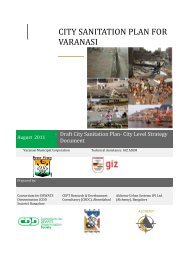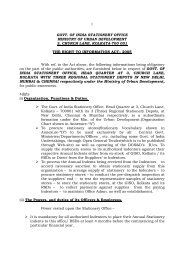CITY SANITATION PLAN - Ministry of Urban Development
CITY SANITATION PLAN - Ministry of Urban Development
CITY SANITATION PLAN - Ministry of Urban Development
You also want an ePaper? Increase the reach of your titles
YUMPU automatically turns print PDFs into web optimized ePapers that Google loves.
Context<br />
<strong>CITY</strong> <strong>SANITATION</strong> <strong>PLAN</strong> BAREILLY<br />
Alandur municipality had no underground sewerage system. Households had either septic tanks or<br />
holding tanks, and the municipality was responsible for collecting the sewage periodically in tankers and<br />
disposing it <strong>of</strong>f in low-lying areas. To address these problems, an underground sewerage system was<br />
designed for its current population, as well as for an estimated population <strong>of</strong> 3,00,000 in 2027, with the<br />
objectives <strong>of</strong> improving the standard <strong>of</strong> living <strong>of</strong> the residents; providing for disposal <strong>of</strong> sewage through<br />
an exclusive drainage network; avoiding recurring expenditure on septic tank cleaning; and preventing<br />
groundwater contamination.<br />
Implementation<br />
In 1997, the Government <strong>of</strong> Tamil Nadu decided to provide a sewerage system in 12 selected major<br />
urban centers including Alandur, in the context <strong>of</strong> a World Bank Project. The Chairperson <strong>of</strong><br />
Municipality, Mr. R. S. Bharati, took up the task <strong>of</strong> implementing this. It was decided that Tamil Nadu<br />
<strong>Urban</strong> Infrastructure Finance Services Ltd. (TNUIFSL), the state asset management company, be<br />
approached to finance the sewerage scheme. Considering the lack <strong>of</strong> financial and technical resources at<br />
the municipal level to undertake such an infrastructure project, it was decided by TNUIFSL that the<br />
municipality would undertake the project on a BOQ (Bill <strong>of</strong> Quantities) basis. The sewerage treatment<br />
plant (STP) would be built on a BOT (Build, Operate and Transfer) basis. The project entailed a)<br />
construction <strong>of</strong> an underground sewerage scheme with a network <strong>of</strong> sewer pipelines and manholes, <strong>of</strong><br />
120 kms (including 19 km main and 101 km branch lines); b) construction <strong>of</strong> a pumping house and<br />
installation <strong>of</strong> pumping machinery; and c) construction <strong>of</strong> a sewage treatment plant with a capacity <strong>of</strong><br />
24 MLD (2 units 12 MLD each) on BOT basis to IVRCL and VATec for a period <strong>of</strong> 14 years.<br />
The project work was carried out in two phases. In the first phase (the first two and a half years), 50% <strong>of</strong><br />
the branch sewers, main sewers, pump house including installation <strong>of</strong> machinery, pumping main and<br />
one 12 MLD capacity sewage treatment plant, were completed and commissioned. The remaining work<br />
relating to the project was to be carried out in the next phase. The particular challenges addressed were<br />
communication and consultations with citizens to secure their buy-in and contribution to the sewerage<br />
scheme, technical bottlenecks such as realignments necessitated by the construction <strong>of</strong> subways and<br />
ADMINISTRATIVE STAFF COLLEGE OF INDIA, HYDERABAD Page 214
















